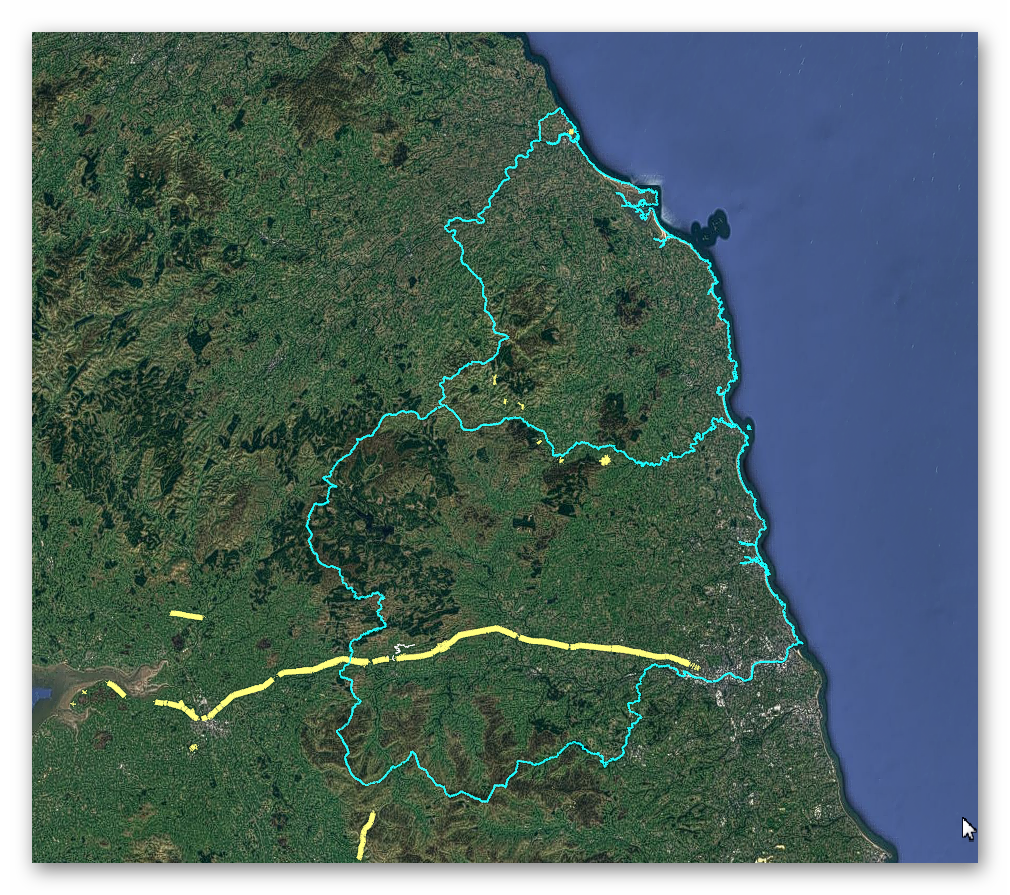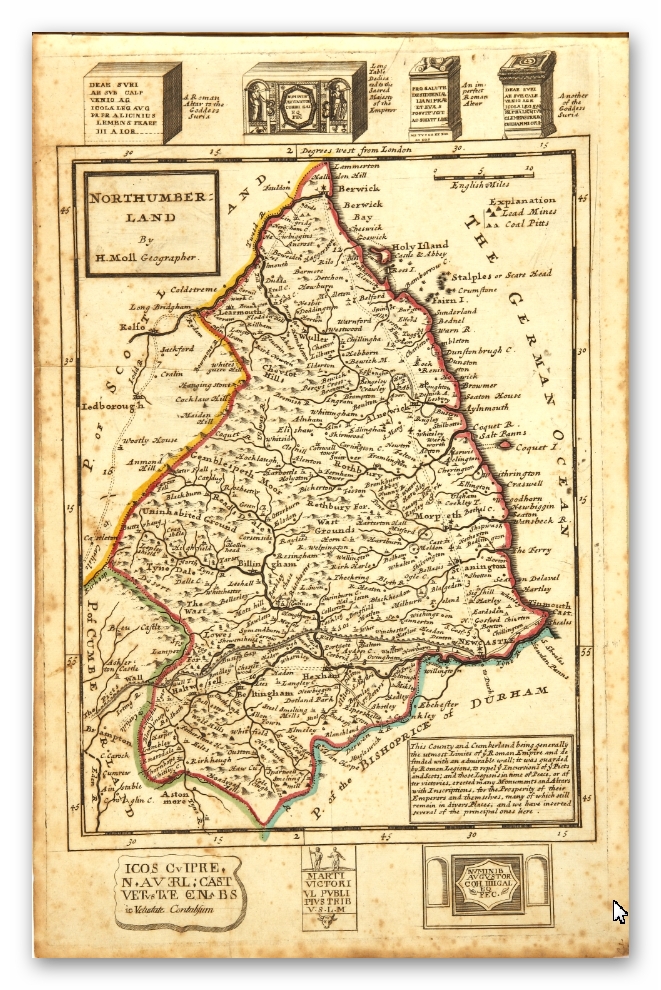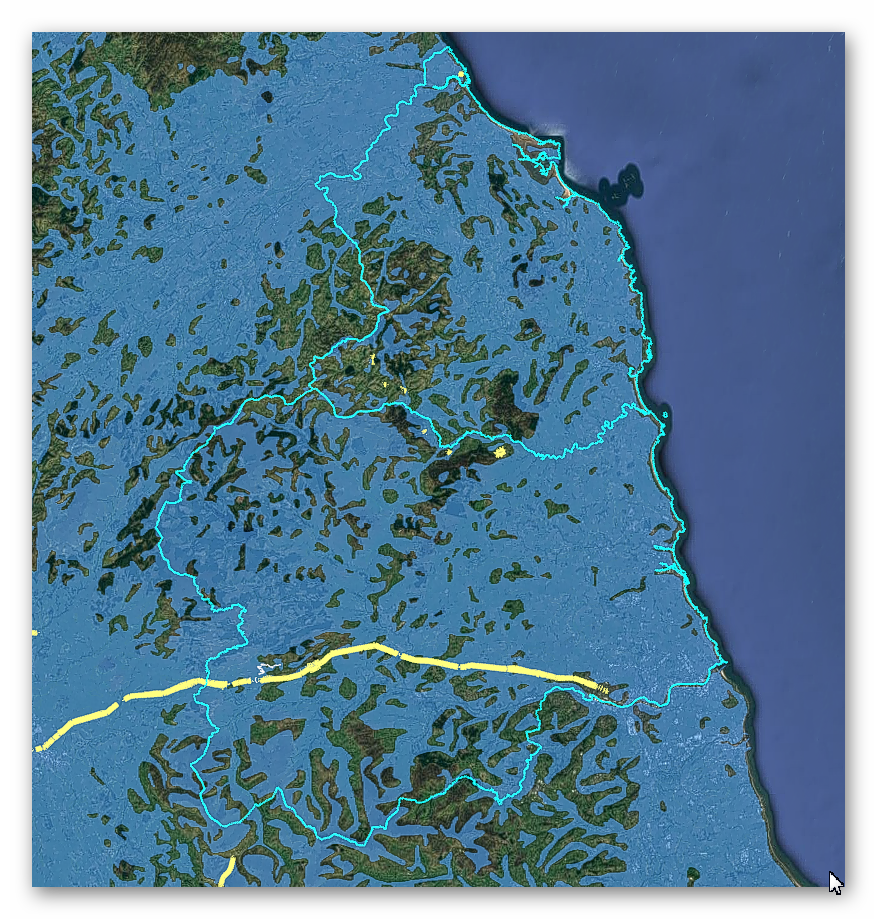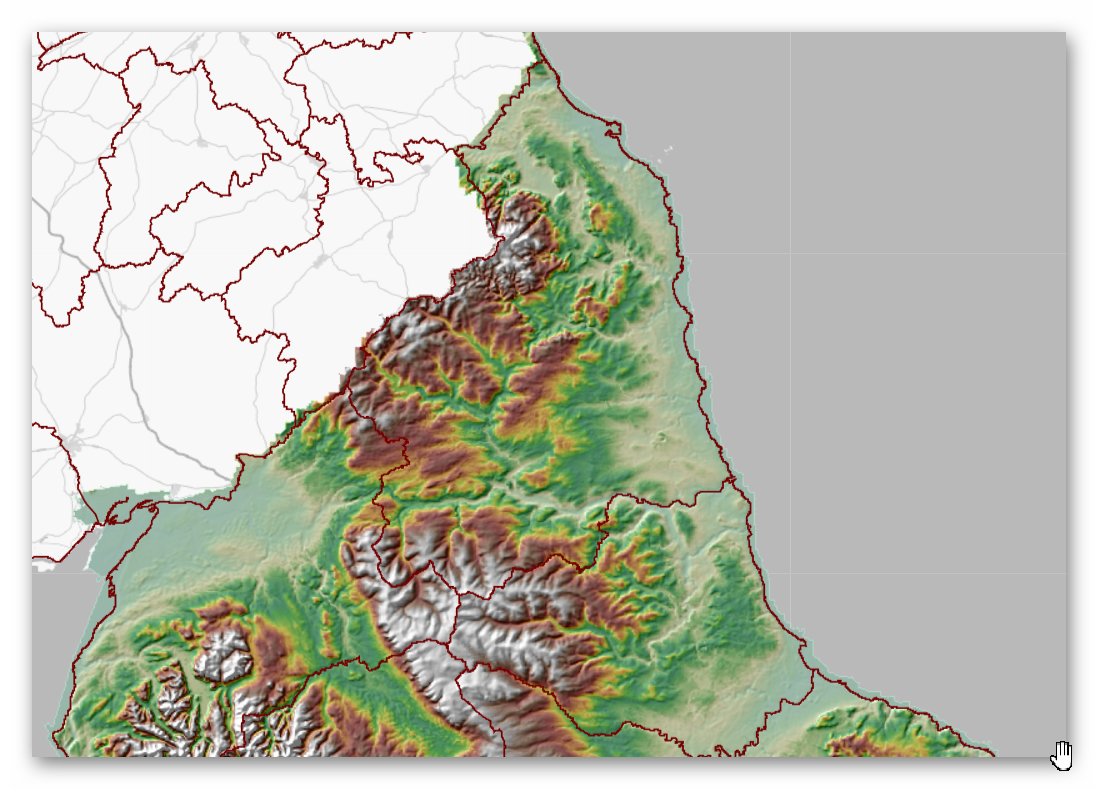Prehistoric Northumberland Canals (Dykes)
GE Map of Prehistoric Northumberland Canals (Dykes)

Old Map

Geological Landscape

Landscape/Terrain

Database of DYKES (Linear Earthworks) in Northumberland
(Click the ‘HE Entry Ref: Number’ (if blue) for more details and Maps)
| Name | HE Entry Ref: | NGF | Length (m) | Overall Width (m) | Ditch Width (m) | Bank Width (m) |
|---|---|---|---|---|---|---|
| Three cross Dykes on Middle Hill | 1007525 | NT87318 12052 | ||||
| Three cross Dykes on Middle Hill | 1007525 | NT87321 12792 | ||||
| Three cross Dykes on Middle Hill (missing) | 1007525 | NT87388 12197 | ||||
| Three cross Dykes on Middle Hill | 1007525 | NT87403 12912 | ||||
| Three cross Dykes on Middle Hill (missing) | 1007525 | NT87440 13004 | 396 | 7 | 3 | 4 |
| Cross dyke, 200m south east of Hosedon Linn | 1008274 | NT 91943 08021 | 341 | 8 | 4 | 4 |
| Cross dyke south east of Uplaw Knowe | 1008275 | NT 91497 08479 | 293 | 8 | 4 | 4 |
| Cross dyke south east of Uplaw Knowe (missing) | 1008275 | NT 91616 08487 | 668 | 8 | 4 | 4 |
| Witchy Neuk univallate hillfort and linear boundary 600m west of Hepple Whitefield Farm | 1008873 | NY 98266 99217 | ||||
| Hadrian's Wall and vallum from Throckley to East Town House, Heddon-on-the-Wall in wall mile 11 | 1010616 | NZ 14310 66842 | ||||
| Hadrian's Wall and vallum from East Town House, Heddon-on-the-Wall to the A69 trunk road in wall mile 12 | 1010617 | NZ 12879 67062 | ||||
| Hadrian's Wall and vallum between the March Burn and Oatens Bank, Harlow Hill in wall miles 13,14 and 15 | 1010618 | NZ 09314 67801 | ||||
| The vallum between Oatens Bank, Harlow Hill, and Whittle Dene Watercourse in wall mile 16 | 1010621 | NZ 07214 68050 | ||||
| Hadrian's Wall and vallum between the B6309 and the B6321 in wall miles 16, 17 and 18 | 1010622 | NZ 05078 68302 | ||||
| Hadrian's Wall and vallum between Sunnybrae at Halton Shields and Haltonchesters Roman fort in wall miles 20 and 21 | 1010623 | NZ 00877 68579 | ||||
| Hadrian's Wall and vallum between the Fence Burn and the track to Portgate Cottage in wall miles 21 and 22 | 1010625 | NY 98763 68461 | ||||
| Hadrian's Wall and vallum between the track to Portgate Cottage and the field boundary east of milecastle 24 in wall miles 22 and 23 | 1010626 | NY 97047 69032 | ||||
| Hadrian's Wall and vallum between field boundary east of milecastle 24 and field boundary west of the site of turret 25b in wall miles 24 to 25 | 1010958 | NY 94794 69391 | ||||
| Hadrian's Wall and vallum between Chesters and the road to Simonburn in wall miles 27, 28 and 29 | 1010960 | NY 89572 70805 | ||||
| Hadrian's Wall and vallum between the road to Simonburn and the field boundary east of Carrawburgh car park in wall miles 29, 30 and 31 | 1010961 | NY 87219 71460 | ||||
| Hadrian's Wall and vallum between the field boundary west of Coventina's Well and the field boundary at Brown Dikes in wall miles 31 and 32 | 1010962 | NY 84604 70985 | ||||
| Hadrian's Wall and vallum between the field boundary at Brown Dikes and the field boundary east of turret 34a in wall miles 32, 33 and 34 | 1010963 | NY 82560 70612 | ||||
| The vallum and early Roman road between the field boundary east of turret 34a and the field boundary west of milecastle 36 in wall miles 34, 35 and 36 | 1010965 | NY 80554 69615 | ||||
| The vallum and a British settlement between the field boundary west of turret 37a and the road to Steel Rigg car park, in wall miles 37, 38 and 39 | 1010972 | NY 76692 67307 | ||||
| The vallum between the road to Steel Rigg car park and the road in Caw Gap in wall miles 39, 40 and 41 | 1010974 | NY 74002 66774 | ||||
| Hadrian's Wall and vallum between the road to Caw Gap and the Caw Burn in wall miles 41 and 42 | 1010975 | NY 71916 66692 | ||||
| The vallum between Cockmount Hill and Walltown Quarry West in wall miles 43, 44 and 45 | 1010978 | NY 68462 66300 | ||||
| Hadrian's Wall and vallum between the field boundary west of Carvoran Roman fort and the west side of the B6318 road in wall mile 46 | 1010992 | NY 65974 65989 | 775 | 36 | 10 | 13 x 2 |
| Hadrian's Wall, vallum, section of the Stanegate Roman road and a Roman temporary camp between the B6318 road and Poltross Burn in wall miles 46 and 47 | 1010993 | NY 64601 65984 | ||||
| Cross dyke, South of Campville (missing) | 1011396 | NT 94427 02605 | 418 | 7 | 4 | 3 |
| Cross dyke, South of Campville (missing) | 1011396 | NT 94687 02165 | ||||
| Cross dyke, South of Campville | 1011396 | NT 94702 02223 | ||||
| Carrawburgh Roman fort and Hadrian's Wall and vallum between the field boundary east of the fort and the field boundary west of Coventina's Well in wall mile 31 | 1015914 | NY 85746 71169 | ||||
| Lordenshaw multivallate hillfort, Romano-British settlements, field system, cairnfield, cross dyke, round cairn cemetery, rock art and medieval park pale | 1017196 | NZ 05554 99220 | ||||
| Rudchester Roman fort, associated civil settlement and a section of Hadrian's Wall and vallum from the A69 to the March Burn in wall mile 13 | 1017533 | NZ 11538 67420 | ||||
| Hadrian's Wall and vallum between the B6321 and Sunnybrae at Halton Shields, in wall miles 18 and 19 | 1017534 | NZ 02781 68574 | ||||
| Cross Dyke and two building foundations at Copper Snout | 1017736 | NT 89038 08885 | 474 | 6 | 3 | 3 |
| Hadrian's Wall and vallum between St Oswald's Cottages, east of Brunton Gate and the North Tyne in wall miles 25, 26 and 27 | 1018581 | NY 92493 69695 | ||||
| Housesteads fort, section of Wall and vallum between the field boundary west of milecastle 36 and the field boundary west of turret 37a in wall miles 36 and 37 | 1018585 | NY 78838 68489 |
Dykes Ditches and Earthworks
Indeed, the modern term “dyke” or “dijk” can be traced back to its Dutch origins. As early as the 12th century, the construction of Dykes in the Netherlands was a well-established practice. One remarkable example of their ingenuity is the Westfriese Omringdijk, stretching an impressive 126 kilometres (78 miles), completed by 1250. This Dyke was formed by connecting existing older ‘dykes’, showcasing the Dutch mastery in managing their aquatic landscape.
The Roman chronicler Tacitus even provides an intriguing historical account of the Batavi, a rebellious people who employed a unique defence strategy during the year AD 70. They punctured the Dykes daringly, deliberately flooding their land to thwart their enemies and secure their retreat. This historical incident highlights the vital role Dykes played in the region’s warfare and water management.
Originally, the word “dijk” encompassed both the trench and the bank, signifying a comprehensive understanding of the Dyke’s dual nature – as both a protective barrier and a channel for water control. This multifaceted concept reflects the profound connection between the Dutch people and their battle against the ever-shifting waters that sought to reclaim their land.
The term “dyke” evolved as time passed, and its usage spread beyond the Dutch borders. Today, it represents not only a symbol of the Netherlands’ engineering prowess but also a universal symbol of human determination in the face of the relentless forces of nature. The legacy of these ancient Dykes lives on, a testament to the resilience and innovation of those who shaped the landscape to withstand the unyielding currents of time.
Upon studying archaeology, whether at university or examining detailed ordinance survey maps, one cannot help but encounter peculiar earthworks scattered across the British hillsides. Astonishingly, these enigmatic features often lack a rational explanation for their presence and purpose. Strangely enough, these features are frequently disregarded in academic circles, brushed aside, or provided with flimsy excuses for their existence. The truth is, these earthworks defy comprehension unless we consider overlooked factors at play.
One curious observation revolves around the term “Dyke,” inherently linked to water. It seems rather peculiar to apply such a word to an earthwork atop a hill unless an ancestral history has imparted its actual function through the ages. Let us consider the celebrated “Offa’s Dyke,” renowned for its massive linear structure, meandering along some of the present boundaries between England and Wales. This impressive feat stands as a testament to the past, seemingly demarcating the realms of the Anglian kingdom of Mercia and the Welsh kingdom of Powys during the 8th century.
However, delving further into the evidence and historical accounts challenges this seemingly straightforward explanation. Roman historian Eutropius, in his work “Historiae Romanae Breviarium”, penned around 369 AD, mentions a grand undertaking by Septimius Severus, the Roman Emperor, from 193 AD to 211 AD. In his pursuit of fortifying the conquered British provinces, Severus constructed a formidable wall stretching 133 miles from coast to coast.
Yet, intriguingly, none of the known Roman defences match this precise length. Hadrian’s Wall, renowned for its defensive prowess, spans a mere 70 miles. Could Eutropius have referred to Offa’s Dyke, which bears remarkable similarity to the Roman practice of initially erecting banks and ditches for defence?
For more information click HERE
Further Reading
For information about British Prehistory, visit www.prehistoric-britain.co.uk for the most extensive archaeology blogs and investigations collection, including modern LiDAR reports. This site also includes extracts and articles from the Robert John Langdon Trilogy about Britain in the Prehistoric period, including titles such as The Stonehenge Enigma, Dawn of the Lost Civilisation and the ultimate proof of Post Glacial Flooding and the landscape we see today.
Robert John Langdon has also created a YouTube web channel with over 100 investigations and video documentaries to support his classic trilogy (Prehistoric Britain). He has also released a collection of strange coincidences that he calls ‘13 Things that Don’t Make Sense in History’ and his recent discovery of a lost Stone Avenue at Avebury in Wiltshire called ‘Silbury Avenue – the Lost Stone Avenue’.
Langdon has also produced a series of ‘shorts’, which are extracts from his main body of books:
For active discussions on the findings of the TRILOGY and recent LiDAR investigations that are published on our WEBSITE, you can join our and leave a message or join the debate on our Facebook Group.
